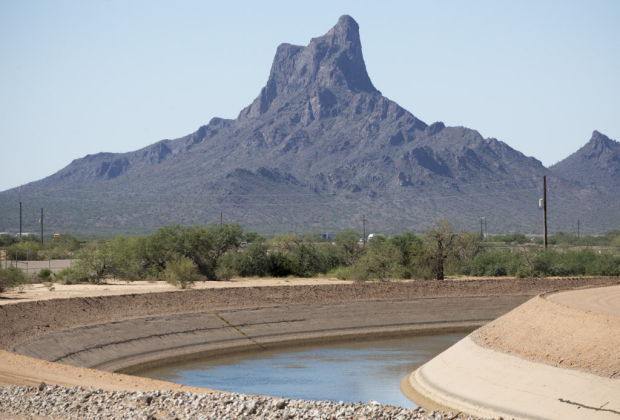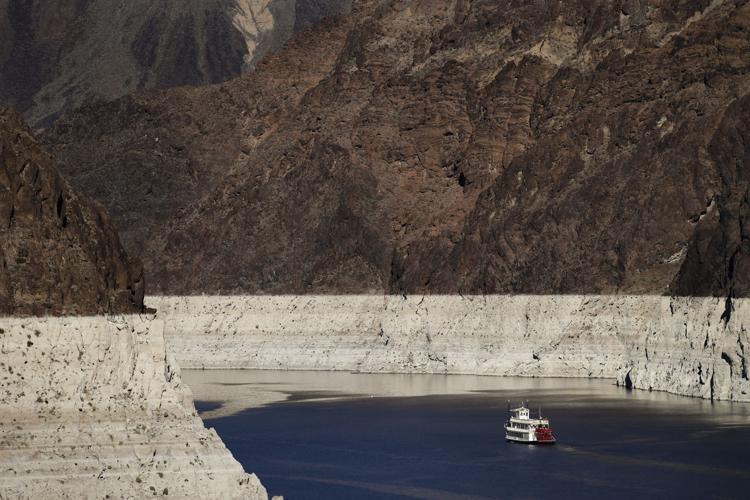LAS VEGAS, Nevada — A long-term plan for protecting Lake Mead and preventing severe shortages in deliveries of Colorado River water to Arizona and two other states won’t be approved before the Obama administration ends, throwing more uncertainty into the outlook.
While the three states keep discussing a drought contingency plan, Arizona water officials say they’ve reached general agreement with water users here for a shorter-term fix for Lake Mead’s chronic declines.
The Arizona plan calls for cities, farms and Indian tribes to keep enough water in Mead through 2019 to lower the risks of the first round of shortages of Central Arizona Project water deliveries. Such shortages would hurt agriculture significantly, although not enough to threaten viability of the CAP, which delivers drinking water to Tucson and Phoenix and irrigation water to central Arizona farmers.
Federal and state water officials announced at a water conference here last week that too many issues remain unresolved to wrap up the major regional drought plan, in the works for three and a half years. They’re optimistic agreement can be reached next year and perhaps in the first few months. They said they hope that if they’re close to agreement, the new Trump administration won’t want to change it radically.
The Arizona plan can act as a bridge, helping the over-allocated Colorado River water system until a long-term plan is in place, said Arizona Water Resources Department and CAP officials at the Colorado River Water Users Association conference.
Standing in the way of the short-term fix, however, is money. It will cost up to $60 million to compensate Arizona users who give up their CAP water to make the short-term plan work, said Terry Fulp, Lower Colorado regional director for the U.S. Bureau of Reclamation, which runs the river reservoir system.
Asked how confident he is of finding that money in the next few months, Fulp replied, “That’s a really good question. I don’t know if we have a really good answer. All I can tell you is that we’re working hard to do that.”
Meanwhile, standing in the way of the long-term fix are two longstanding water disputes in California. One is the fate of the Salton Sea in the southern California desert, which in January 2018 is slated to lose 200,000 acre feet of water that’s to be transferred to San Diego under a 2003 agreement.
At that point, many authorities are worried that the exposed playa’s salt and heavy-metal tainted soils will blow around, triggering massive air pollution.
The sea’s water is runoff from the neighboring Imperial Valley Irrigation District, which controls huge amounts of Colorado River water and is reluctant to give up more under the proposed drought plan unless something can be done to shore up the sea. It wants to see a detailed “road map” outlining what California will do to fix the looming problems there.
The other is a $15 billion proposal to build twin tunnels under the Sacramento-San Joaquin Delta to improve the reliability of water deliveries from northern to southern California.
The Metropolitan Water District in Los Angeles wants to see progress toward building the tunnels — which are heavily opposed by other groups — to ensure that it will have enough other water if it gives up Colorado River water under the drought agreement.
‘BITTERSWEET’ FAILURE
Outgoing Bureau of Reclamation Commissioner Estevan Lopez told conferees Friday that the failure to reach agreement is “bittersweet.”
“There’s been an incredible amount of work by the states and water users, and by the U.S. with Mexico, to do what we have to do to prepare ourselves for the possibility that this drought continues,” he said. “We made and thought of some amazing innovations that, once enacted, will provide us some tools that people will figure out how to use to really help to sustain this river system. But we are not there yet.”
Federal officials said they won’t carry out a threat made at this conference a year ago by Deputy Interior Secretary Mike Connor to impose their own Colorado River plan on Arizona, California and Nevada if the states didn’t adopt a plan by now.
“In the first six months of 2016, we have to see progress, coming together” among leaders of the three states, Connor told the Arizona Daily Star a year ago.
Last week, however, Connor told reporters that because the states have installed a “very good framework” for the long-term drought plan and made progress toward approving it, the feds won’t step in.
“But we will leave that strategy in place” for the incoming Trump administration if the three states can’t reach agreement next year, he said.
Environmentalist John Weisheit, head of the Utah-based group Living Rivers, said he was disappointed the feds aren’t following up on the threat.
“The states didn’t follow through and neither did the federal government. This is a joke. Somebody should be fired,” said Weisheit, predicting an agreement will never be reached. “They’ve known about this problem (of an over-allocated Colorado River) for decades. Even if they do a drought contingency plan, it’s not going to be sufficient in the long term. Why aren’t they doing a 60-year plan?”
Arizona Water Resources Director Tom Buschatzke said as far as he’s concerned, “failure is not an option.” But while the state has pretty broad support for the plan, “the details are still in flux. Details matter. We have to make all pieces of the puzzle fit together. We have forward momentum.”
For now, “we find ourselves in a very precarious situation on the Colorado,” Lopez, the Bureau of Reclamation commissioner, told the conference Friday.
“In 2007, we were in an eight-year drought ... (lakes) Mead and Powell combined were at 47 percent of normal. Now, we’re in our 17th year of drought. It’s the driest 17-year period in recorded history. ... Our combined storage today is 43 percent.”
He pointed to photos showing Mead’s bathtub ring, standing about as high as a 15-story building, and displaying salts left behind by disappearing water. “If we had another five years like 2000 to 2005, we would be in very dire straits right now. That’s why we’re working so hard on this,” he said.
2 river-saving plans detailed
The main drought contingency plan calls for Arizona to give up 512,000 acre feet of water — enough for more than a million homes — once Mead drops below 1,075 feet at the end of any year. The reclamation agency predicts about a 50 percent chance of that by the end of 2017. Under the plan, farmers would take the largest share of cuts, by far, although Indian tribes would also stand to lose water.
For the long term, Arizona, Nevada, California and the bureau would give up 1.2 million acre feet total if the lake hit 1,025 feet. The goal is to keep the lake from dropping below 1,020 feet — a point where major urban water deliveries would be jeopardized and Hoover Dam couldn’t deliver electric power.
Under Arizona’s temporary plan, the state would leave in Mead 400,000 acre feet a year through 2019. Arizona is already leaving nearly 200,000 acre feet a year.
The river’s current guidelines for dealing with shortages and the initial drought plan are viewed by some “as penalizing or harming certain classes of water users disproportionately,” CAP General Manager Ted Cooke said last week.
The temporary Arizona plan would “kind of balance those things out a little bit.” Higher priority users would voluntarily forbear their use of water so lower priority users could keep their water longer. Some users who don’t give up water may be expected to join the feds and state in compensating those who do.
The biggest cuts under the Arizona plan would most likely hit the Gila River Indian Community in Sacaton in northern Pinal County. The tribe controls by far the biggest share of CAP water — 311,000 acre-feet, more than twice that of Tucson, the next biggest CAP holder.
Farmers say it would be hard for them to swallow more cuts when they’re already going to be hurt by a 100,000 acre-foot cut scheduled next year that has nothing to do with CAP shortages.
Tucson Water Director Tim Thomure noted the city has already agreed to give up 26,000 acre feet next year. Phoenix would be hard pressed to give up any CAP now because it lacks an adequate well system for a backup, said Phoenix Water Director Kathryn Sorenson; such a system is about five years away.
Some of the water not taken would be left in the lake forever, and couldn’t be withdrawn by even the owners, a concept known as “system conservation.” The rest could be withdrawn by its owners in the future under certain conditions. Owners of the water left in the lake forever would be compensated for it.
“We would contribute a large portion,” Gila tribal attorney Jason Hauter said Friday. He thinks the Tohono O’Odham tribe, which also controls a significant although much smaller CAP share, would also contribute some water, and that other tribes and other non-Indian water entitlement holders would follow suit, he said.
Given the Gila tribe’s large share of CAP water, “we see this as an opportunity to provide a solution to this ongoing issue,” said Gila Tribal Governor Stephen Lewis at the conference last week. “We’re looking for long-term stability for our own community. We see this as a regional solution as well. We have longstanding relations with surrounding agricultural communities. We are wanting to ... positively influence drought mitigation and planning for the future.”
The Gila Indian community doesn’t necessarily see this as giving up water — “we see this as an investment in the future. ... Keeping Lake Mead healthier longer benefits all parties and definitely benefits the community as well,” Lewis said.
Paul Orme, attorney for four irrigation districts, still has a lot of questions about the money: “There is no pile of $60 million that we can latch onto. It will have to come from a variety of sources, a bit at a time.”






